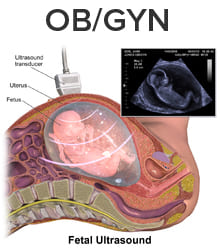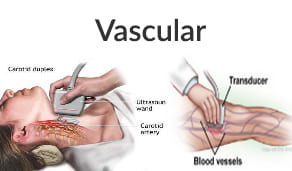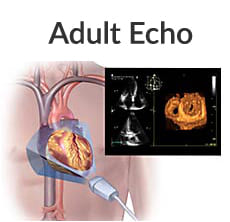What’s the difference between various ultrasound programs is the most common question that pops up when a student is trying to enroll her/himself in one of the allied healthcare programs. The bigger question for most is, “Which field is best for me?” Here, we look at the ultrasound technician or sonography careers and break down all the differences you need to understand to choose the best allied healthcare career for you. At AIHT Education we offer three different sonography programs: Diagnostic Medical Sonography, Cardiovascular Technologist and Vascular Technologist. Before we take a look into each of these careers, lets take a step back to review the basics of the field.
What is the difference between Ultrasound and Sonography?
Often, the terms sonogram and ultrasound are used interchangeably. However, there’s a difference between the two: An ultrasound is a tool used to take a picture. A sonogram is the picture that the ultrasound generates. Sonography is the use of an ultrasound tool for diagnostic purposes. In short, an ultrasound is the process, while a sonogram is the end result. Sonography is a noninvasive, painless procedure. It uses high-frequency sound waves — called ultrasound waves —to produce images of organs, soft tissues, blood vessels, and blood flow, from inside the body. These images are used for medical analysis. Ultrasound is one of the most commonly used form of diagnostic imaging. It helps doctors gain insights into the inner workings of the body, and is known for being, safe, radiation free, noninvasive and widely accessible.
How does Sonography work?
At its most basic level, sonography is seeing through solid material with sound. It works a bit like sonar, except instead of sending sound waves through water to find ships and submarines, it uses sound waves to create images of bones, tumors, and even babies.
The other main difference is in frequencies. Sonar sticks to very low frequencies, around 5 Hz. Sonograms, also known as ultrasounds, use sound waves of around 20,000 Hz. The good news is that this is just at the high end of human hearing (which is about 20 Hz to 20,000 Hz), so you’re unlikely to hear anything yourself.
Why the big difference? With sonar, the sound waves travel for many miles, while ultrasound only travels a few inches. That precision allows for the same basic set of technology to do different things for different specialists.
What does a Diagnostic Medical Sonographer do?
The key role of this professional is to conduct sonographic exam to create images to aid physicians in assessing and diagnosing medical conditions of patients. Scheduling and coordinating tests, recording test results, and preparing and maintain operational logs are few other responsibilities that a sonographer is accounted for.
In this program, students learn to perform diagnostic sonographic examinations. They are taught to use ultrasonic equipment to locate, evaluate and record critical functional, pathological, and anatomical data. The core abdomen and small parts module covers scanning techniques of abdominal organs like liver, biliary tree, pancreas, spleen, gall bladder, kidney, urinary bladder and appendix. It also covers the pathology of abdomen organs and small parts like thyroid glands, parathyroid glands, prostate, scrotum and breasts. The vascular module cover the basic introduction to the vascular ultrasound and the OB/GYN module includes scanning techniques of Pelvic organs like ovaries, uterine tubes and cervix.
This program not only prepares students to become a skilled sonographer but also provide them with the prerequisite knowledge of the vital principles and instrumentation of Diagnostic Ultrasound.
What does a Cardiovascular Technologist do?
The key role of this professional is to conduct tests on cardiovascular systems of patients for diagnostic purposes. They may conduct or assist in electrocardiograms, and cardiac catheterizations, and similar tests.
In this program, students learn about the normal physiology as well as the pathology of the heart and blood vessels. The core module adult echo covers basic introduction to echocardiography which includes the Heart Doppler – velocities and pressures Trans esophageal and stress echo Cardiac masses, infection and congenital abnormalities. The core vascular scanning module covers the basic concept about vasculature, the vascular anatomy and pathology related to vessels.
This program provide the students with required knowledge and skills in order to become a successful Cardiovascular Technologists in the future.
What does a Vascular Technologist do?
The key role of this professional is to conduct sonographic exam to create images in order to help physicians assess and diagnose medical conditions. Scheduling and coordinating tests, recording test results, and preparing and maintain operational logs are few other responsibilities that a sonographer is accounted for. The core module vascular scanning covers the basic concept about vasculature, the vascular anatomy and pathology related to vessels.
This program will equip students with the essential knowledge of the vital principles and instrumentation of Vascular Ultrasound.
How can I become a Sonographer?
AIHT Education is an accredited healthcare training school in Stratford CT that offers three different sonography programs: Diagnostic Medical Sonography, Cardiovascular Technologist and Vascular Technologist. Visit our website at aiht.edu to schedule an appointment to speak with an admission counselor. Our friendly and knowledgeable counselors will help you get acquainted with AIHT and our professors, discuss our training programs and answer any and all questions you may have. Your future in healthcare starts at AIHT Education.








